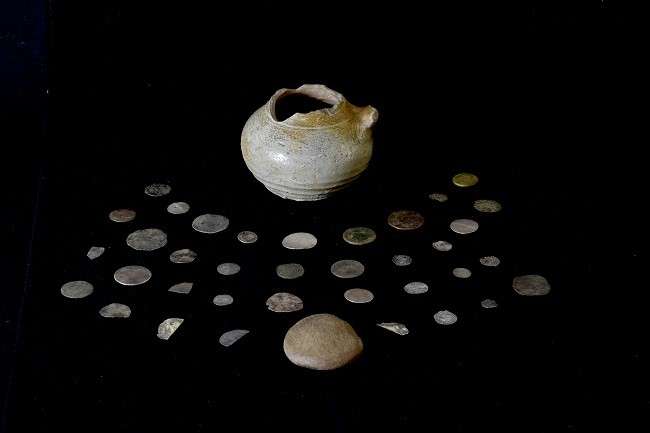They were hidden for safekeeping underneath a stone fireplace. But they were never retrieved until now, some 330 years later. Now archaeologists have revealed that a hoard of coins buried in a small pot, just discovered in Glencoe paints a fascinating picture of life for one Highland clan chief and his household. The site in Glencoe was used as a “summerhouse” and traditionally associated with Alasdair Ruadh “MacIain” MacDonald of Glencoe, chief of the MacDonalds of Glencoe from 1646-1692. The 36 coins, which vary in date, were discovered by University of Glasgow archaeology student Lucy Ankers in the grand fireplace of the Glencoe house during an archaeological dig in August 2023.
The coins were found in a pot, with a small rounded pebble for a lid and hidden beneath a hearth stone stab. However, none of the coins were minted after the 1680s which has led archaeologists to suggest that they were most likely deposited under the fireplace either just before or during the 1692 Glencoe Massacre for safekeeping. Whoever buried the coins, did not return for them which could indicate that they were among the victims of the massacre. The MacDonalds took part in the first Jacobite rising of 1689, this resulted in the clan being targeted in the 1692 Massacre of Glencoe. In late January 1692, two companies or approximately 120 men from the Earl of Argyll’s Regiment of Foot arrived in Glencoe from Invergarry. Their commander was Robert Campbell of Glenlyon. An estimated 38 members and associates of Clan MacDonald of Glencoe were killed on 13 February 1692, including Maclain and his wife.
Dr Michael Given, a Senior Lecturer in Archaeology and Co-Director of the University of Glasgow’s archaeological project in Glencoe, said: “These exciting finds give us a rare glimpse of a single, dramatic event. Here’s what seems an ordinary rural house, but it has a grand fireplace, impressive floor slabs, and exotic pottery imported from the Netherlands and Germany. And they’ve gathered up an amazing collection of coins in a little pot and buried them under the fireplace. What’s really exciting is that these coins are no later than the 1680s: so were they buried in a rush as the Massacre started first thing in the morning of the 13th February 1692? We know some of the survivors ran through the blizzard and escaped up the side glens, including this one: were these coins witnesses to this dramatic story? It’s a real privilege, as archaeologists, to hold in our hands these objects that were so much part of people’s lives in the past.”

